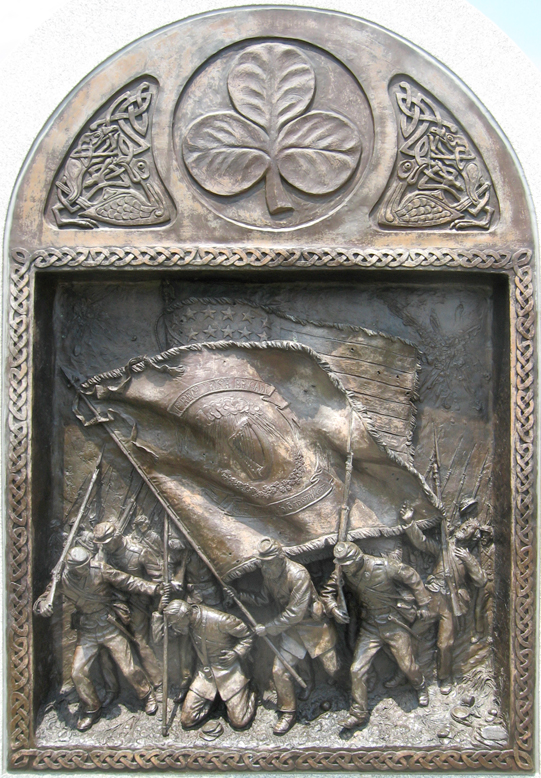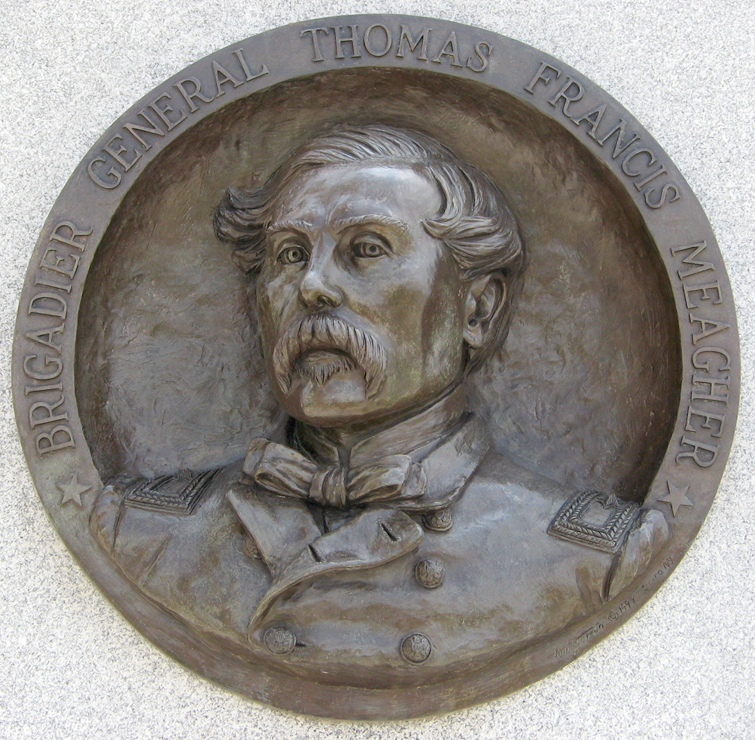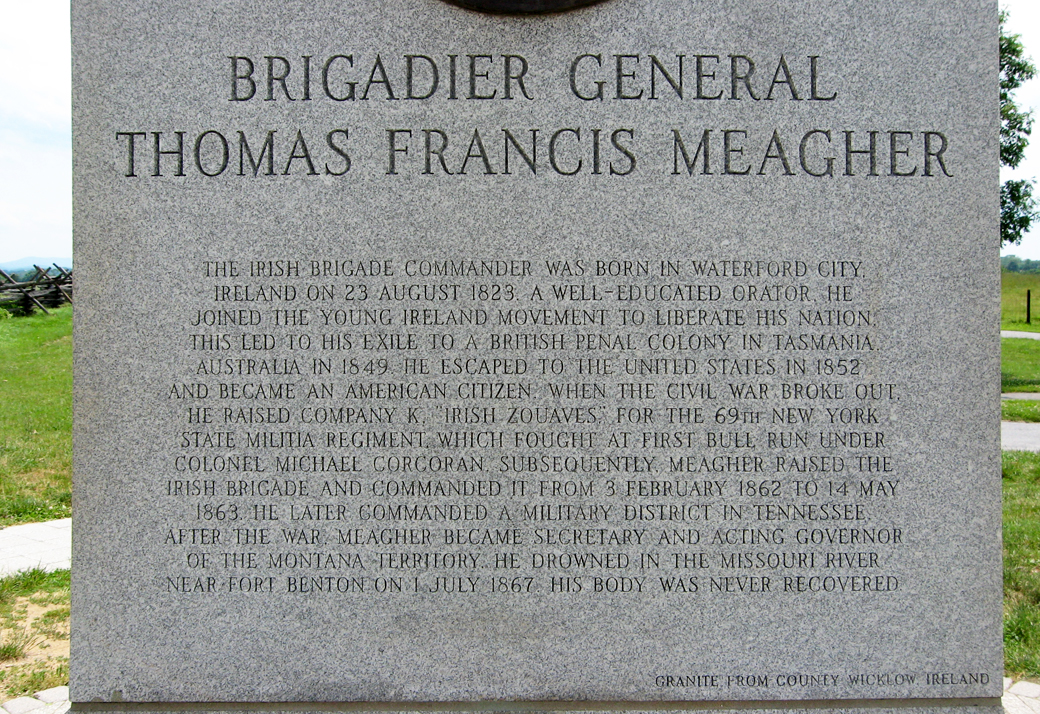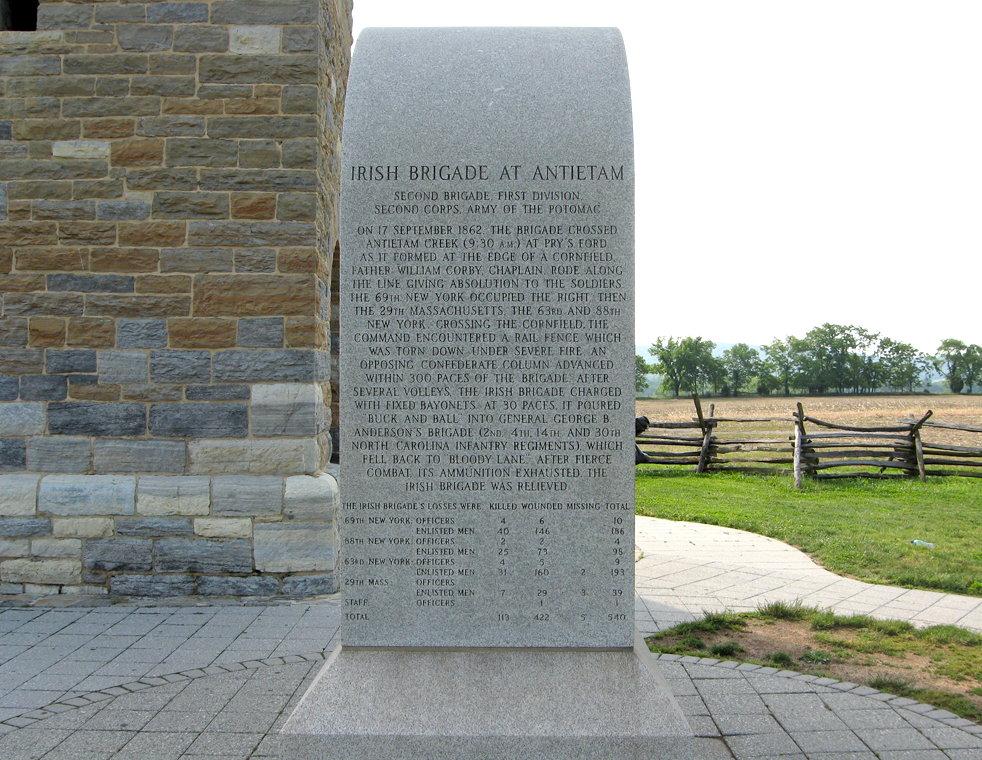New York Monuments at Antietam
The monument to the Irish Brigade at Antietam is at the base of the observation tower at the end of the Sunken Road (or Bloody Lane). (Sunken Road East tour map). It was dedicated on October 25, 1997.
The heart of the monument is a ten foot tall, fifteen ton block of granite brought from County Wicklow, Ireland. On the front of the monument a bronze bas-relief shows the charge of the Irish brigade at Antietam. On the rear of the monument us a bas-relief of Brigadier General Thomas Francis Meagher, who raised the brigade and commanded it until early 1863. The bronze reliefs were created by sculptor Ron Tunison, who also created the Friend to Friend Masonic Memorial, General Samuel Crawford monument, Women’s Memorial and bas relief on the Delaware State Monument at Gettysburg.

From the front of the monument:
Irish Brigade

Closeup of the bronze bas-relief from the front of the monument
From the rear of the monument:

Brigadier General
Thomas Francis Meagher
The Irish Brigade commander was born in Waterford City Ireland on 23 August 1823, a well educated orator, he joined the young Ireland movement to liberate his nation. This led to his exile to a British Penal Colony in Tasmania Australia in 1849. He escaped to the United States in 1853 and became an American citizen. When the Civil War broke out he raised Company K, Irish Zouaves, for the 69th New York State Militia Regiment which fought at First Bull Run under Colonel Michael Corcoran. Subsequently Meagher raised the Irish Brigade and commanded it from 3 February 1862 to 14 May 1863 til later commanded a military district in Tennessee. After the War meagher became Secretary and Acting Governor of the Montana Territory. He drowned in the Missouri River near Fort Benton on 1 July 1867. His body was never recoverd.
Granite from County Wicklow Ireland

From the north side of the monument:
Irish Brigade
Formed in November 1861, the Brigade was largely recruited in New York, Massachusetts and Pennsylvania. Its initial regiments were the 69th, 88th and 63rd New York State Volunteers. Other units identified as part of the Brigade included the 29th Massachusetts, 116th Pennsyvlania and 25th Massachusetts Volunteer Infantry Regiments. The Brigade fought in all of the major campaigns of the Army of the Potomac. It lost over 4,000 men during the war. This total is larger than the number of soldiers who served in the Brigade at any single time. Eleven Brigade members were awarded the Congressional Medal of Honor. Of the Five Officers who commanded the Brigade, three were killed or mortally wounded. Colonel Richard Byrnes (Cold Harbor), Colonel Patrick Kelly (Petersburg), and Brigadier General Thomas A. Smyth (Farmville). The Brigade was mustered out in June 1865.

Irish Brigade at Antietam
Second Brigade, First Division Second Corps, Army of the Potomac On 17, September 1862, the Brigade crossed Antietam Creek (9:30 a.m.) at Pry’s Ford. As it formed at the edge of a cornfield Father William Corby, Chaplain rode along the line, giving absolution to the soldiers. The 69th New York occupied the right then the 29th Massachusetts, the 63rd and 88th New York crossing the cornfield, the command encountered a rail fence which was torn down under severe fire an opposing Confederate column advanced within 300 paces of the brigade . After several volleys, the Irish Brigade charged with fixed bayonets. At 30 paces it poured buck and ball into General George B. Anderson’s Brigade (2nd, 4th, 14th and 30th North Carolina Infantry Regiments) which fell back to “Bloody Lane”. After fierce combat its ammunition exhausted the Irish Brigade was relieved.
| The Irish Brigade Losses Were |
Killed |
Wounded |
Missing |
Total |
|
| 69th New York | Officers |
4 |
6 |
10 |
|
| Enlisted Men |
40 |
146 |
186 |
||
| 88th New York | Officers |
2 |
2 |
4 |
|
| Enlisted Men |
25 |
73 |
98 |
||
| 63rd New York | Officers |
4 |
5 |
9 |
|
| Enlisted Men |
31 |
160 |
2 |
193 |
|
| 29th Massachusetts | Officers | ||||
| Enlisted Men |
7 |
29 |
3 |
39 |
|
| Staff | Officers |
1 |
1 |
||
| Total |
113 |
422 |
5 |
540 |
|

The west side of the Irish Brigade monument at Antietam
During the assault on the Sunken Road General Meagher was stunned by a fall from his horse and had to give up command of the brigade. According to the general, his horse was shot. Some claimed whiskey was a contributing factor, but there was never any proof.
The “buck and ball” at 30 paces referenced on the monument was the result of a command decision by General Meagher to equip the brigade with smoothbore muskets rather than longer range rifles. He felt his men were close-range fighters, and a smoothbore firing a load of ball and buckshot was deadly at close range.
After Meagher left the field Colonel John Burke of the 63rd New York then took command of the brigade. But Colonel Burke mysteriously disappeared during the battle. Lieutenant Colonel Henry Fowler took over the 63rd when Burke disappeared, but was wounded, leaving command to Captain Joseph O’Neill, the only officer of the 63rd not killed or wounded during the attack. After the battle Burke was charged with abandoning his regiment, and was court martialled and dismissed from the service. See more on the history of the 63rd New York Infantry in the Civl War
The 69th New York was commanded by Lieutenant Colonel James Kelley, who was wounded in the face and shoulder. Major James Cavanagh then took over command. See more on the history of the 69th New York Infantry in the Civil War
The 88th New York was commanded by Lieutenant Colonel Patrick Kelly, who survivied the battle unscathed and went on to command the brigade at Gettysburg before being killed at Petersburg in 1864. See more on the history of the 88th New York Infantry in the Civil War
The 29th Massachusetts was commanded by Lieutenant Colonel Joseph H. Barnes. See more on the history of the 29th Massachusetts Infantry in the Civil War
There is a monument to the Irish Brigade at Fredericksburg and the Irish Brigade and Father Corby are honored by monuments at Gettysburg.

The view looks north past the monument to the Irish Brigade. Behind it on the right is the monument to Hexamer’s New Jersey Battery, while the set of War Department markers for the Army of Northern Virginia and Army of the Potomac are on the left. The base of the Observation Tower is on the right of the photo.
